Mitsubishi Outlander Sport (2022 year). Manual in english - page 16
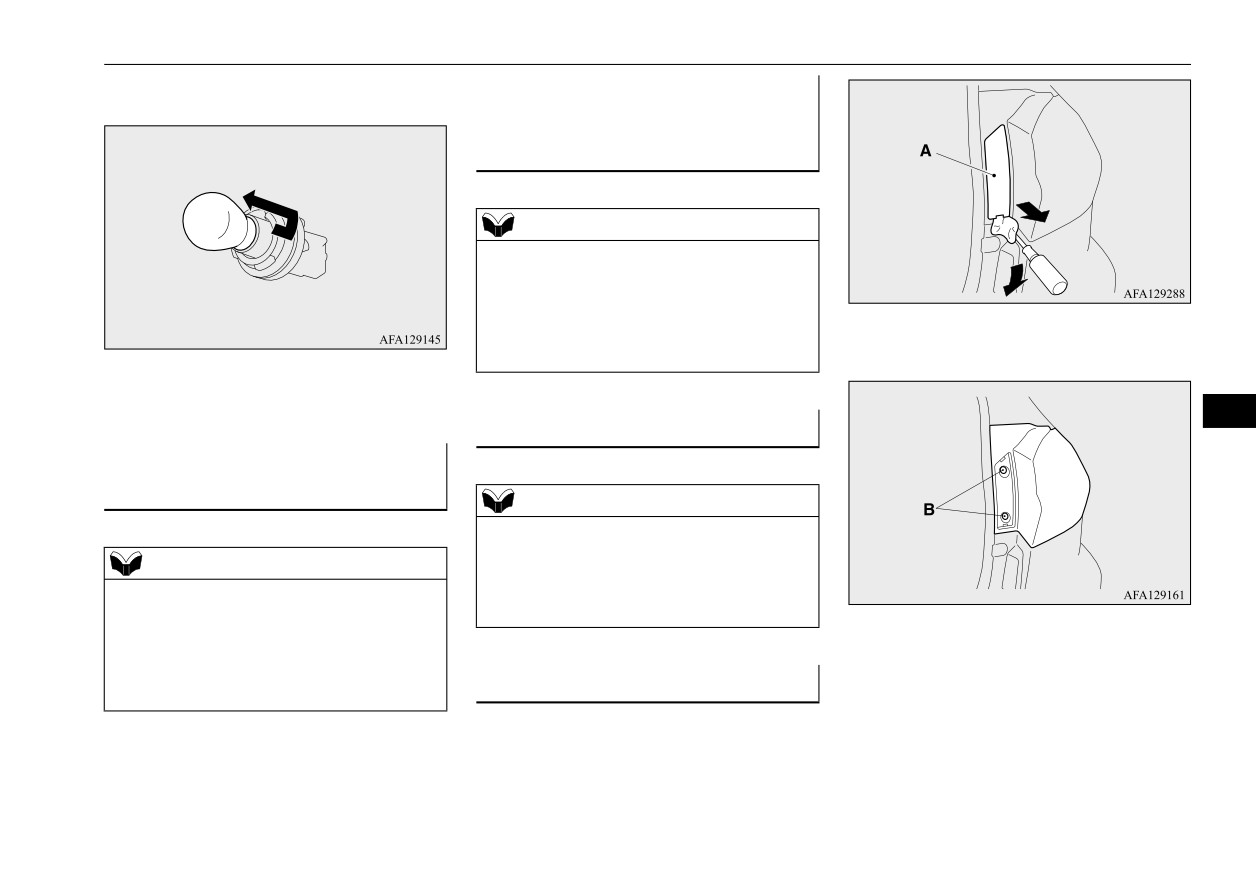
Replacement of light bulbs
3. Remove the bulb from the socket by turn-
Side turn signal lights (on out-
ing it counterclockwise while pressing in.
side rearview mirror)
(if so
equipped)
N00943501222
NOTE
z The side turn signal lights (on outside rear-
view mirror) use an LED.
Check with an authorized Mitsubishi Motors
dealer or a repair facility of your choice
when the light needs to be repaired or
3. Remove the screws (B) that hold the light
replaced.
unit and remove the light unit.
4. To install the bulb, perform the removal
steps in reverse.
9
Front fog lights (if so equipped)
N00943602028
Side turn signal lights (on
fender) (if so equipped)
NOTE
N00943501150
z The front fog lights use an LED.
Check with an authorized Mitsubishi Motors
NOTE
dealer or a repair facility of your choice
z It is not possible to repair or replace only the
when the light needs to be repaired or
bulb for the side turn signal light.
replaced.
Check with an authorized Mitsubishi Motors
4. Turn the socket and bulb assembly coun-
dealer or a repair facility of your choice
terclockwise to remove it.
when the light needs to be repaired or
Rear combination lights
replaced.
N00943701657
1. Open the liftgate.
2. Insert a flat-blade screwdriver with a cloth
over its tip into the notch of the cover (A),
and then pry gently as shown to remove it.
Vehicle care and maintenance
9-33

Replacement of light bulbs
Tail lights
N00956100023
NOTE
z The tail lights use an LED.
Check with an authorized Mitsubishi Motors
dealer or a repair facility of your choice
when the light needs to be repaired or
replaced.
C- Rear side-marker light, stop light, and
6. To install the bulb, perform the removal
Back-up lights
tail and stop light (LED)
steps in reverse.
N00929101107
- cannot be replaced
D- Rear turn signal light
NOTE
9
NOTE
z The back-up lights use an LED.
z When mounting the light unit, align the
Check with an authorized Mitsubishi Motors
NOTE
groove (E) on the light unit with the clip on
dealer or a repair facility of your choice
z The rear side-marker lights, stop lights, and
the body and the pin (F) on the unit with the
when the light needs to be repaired or
the tail and stop lights use an LED.
hole in the body.
replaced.
Check with an authorized Mitsubishi Motors
dealer or a repair facility of your choice
when the light needs to be repaired or
replaced.
5. Pull the bulb out of the socket.
9-34
Vehicle care and maintenance
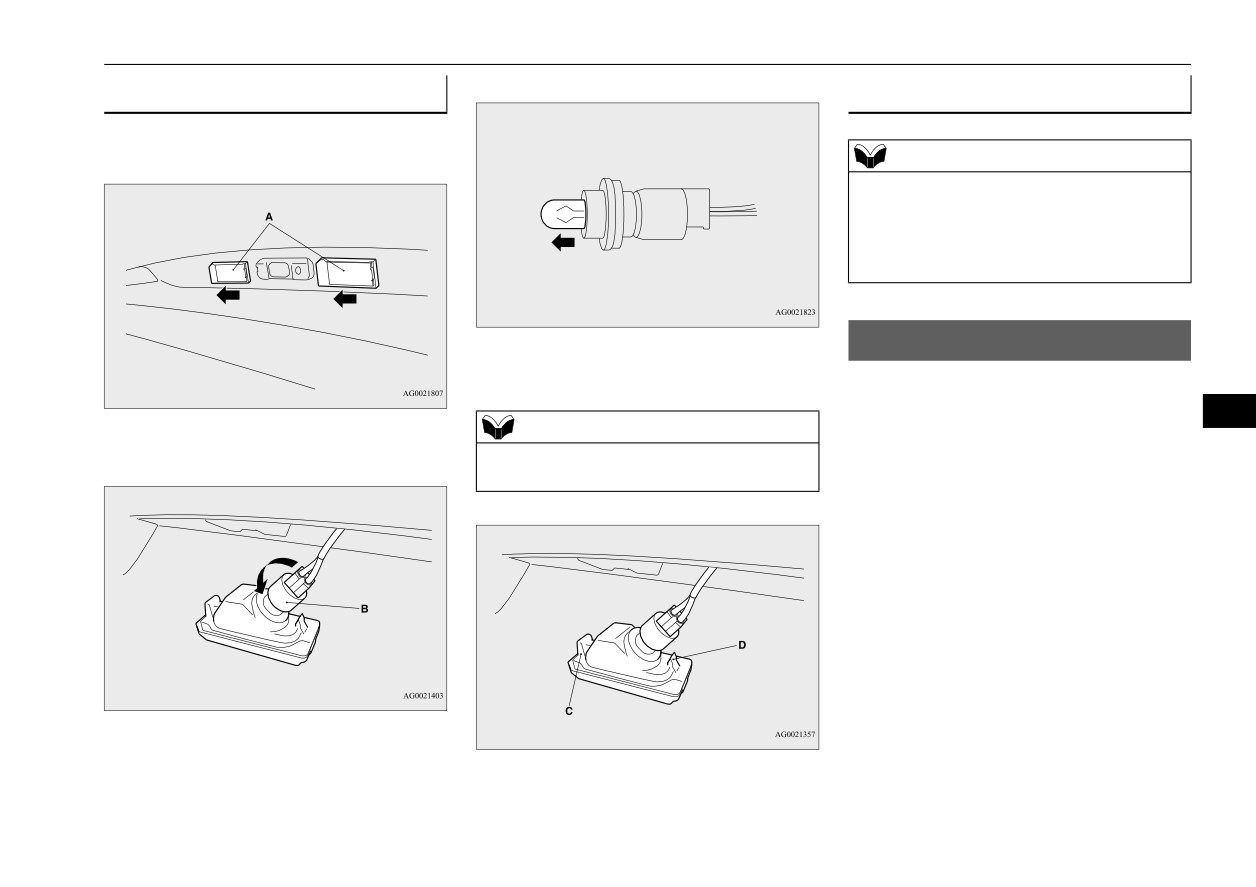
Vehicle care precautions
3. Pull the bulb out of the socket.
License plate lights
High-mounted stop light
N00944000386
N00943901183
1. When removing the light unit (A), push it
toward the left side of the vehicle body.
NOTE
z The high-mounted stop light uses an LED.
Check with an authorized Mitsubishi Motors
dealer or a repair facility of your choice
when the light needs to be repaired or
replaced.
Vehicle care precautions
4. To install the bulb, perform the removal
N00945100166
steps in reverse.
In order to maintain the value of your vehicle,
perform regular maintenance using the proper
9
NOTE
2. Remove the socket (B) and bulb assembly
materials and procedures. Be sure to use only
z When mounting the light unit, insert tab (C)
by turning it counterclockwise.
those materials and procedures that meet your
first then align tab (D) with its hole.
local environmental pollution control regula-
tions. Choose the materials you will use care-
fully, to be sure that they do not contain
corrosives. If you are not sure, contact an
authorized Mitsubishi Motors dealer for help
in choosing these materials.
Vehicle care and maintenance
9-35
Cleaning the inside of your vehicle
CAUTION
CAUTION
NOTE
z
Cleaning products can be dangerous. Some
z Do not use organic substances
(solvents,
z Do not use cleaners, conditioners, and pro-
are poisonous and others are highly flamma-
benzine, kerosene, alcohol, gasoline, etc.) or
tectants containing silicones or wax.
ble. Some are dangerous if you breathe their
alkaline or acidic solutions.
Such products, when applied to the instru-
fumes in a closed space. When you use any-
These chemicals can cause discoloring,
ment panels or other parts, may cause reflec-
thing in a container to clean your vehicle, be
staining or cracking of the surface.
tions on the windshield and obscure vision.
sure to follow the instructions. Always open
If you use cleaners or polishing agents, make
Also, if such products get on the switches of
your vehicle doors or windows when you’re
sure their ingredients do not include the sub-
the electrical accessories, it may lead to fail-
cleaning the inside. Never use the following
stances mentioned above.
ure of these accessories.
chemicals to clean your vehicle:
• Gasoline
• Carbon Tetrachloride
NOTE
Upholstery
• Benzine
z Always read the instructions on the cleaner
N00945500128
• Kerosene
label.
1. To maintain the value of your new vehi-
• Naphtha
cle, maintain the upholstery carefully and
9
• Acetone
keep the interior clean.
• Turpentine
Use a vacuum cleaner and brush to clean
Plastic, vinyl leather, fabric and
• Paint Thinner
the seats. If stained, vinyl and synthetic
flocked parts
• Lacquer Thinner
leather should be cleaned with an appro-
N00945300142
• Nail Polish Remover
priate cleaner. Cloth fabrics can be
1. Lightly wipe these off with a soft cloth
cleaned with either upholstery cleaner or a
soaked in a 3% solution of gentle soap
These can all be dangerous, and they all can
3% solution of gentle soap in lukewarm
and water.
damage your vehicle.
water.
2. To rinse, dip the cloth in fresh water,
2. Clean the carpeting with a vacuum
wring it out well, and wipe off all the
cleaner and remove any stains with carpet
soap.
Cleaning the inside of your
cleaner. Oil and grease can be removed by
vehicle
lightly dabbing with a clean white cloth
N00945200095
and spot remover.
After washing the inside of your vehicle with
any cleaner, wipe it dry in a shady, well venti-
lated area.
9-36
Vehicle care and maintenance

Cleaning the outside of your vehicle
NOTE
NOTE
Washing
z If fuzzing is difficult to remove from the seat
z The genuine leather surface may harden and
N00945901796
upholstery, draw a suitable defuzzing brush
shrink if it is exposed to the direct sunlight
Chemicals contained in the dirt and dust
over the surface in one direction.
for long hours. When your vehicle is parked,
picked up from air, rain, snow, or road sur-
place it in the shade as much as possible.
faces can damage the paint and body of your
z When the temperature of the vehicle interior
vehicle if left on.
rises in summer, vinyl products left on the
Genuine leather
(if so equipped)
Frequent washing and waxing is the best way
genuine leather seat may deteriorate and
N00945600187
to protect your vehicle from this damage.
stick to the seat.
1. To clean, lightly wipe the leather with a
Do not wash the vehicle in direct sunlight.
soft cloth soaked in a 5% solution of gen-
Park the vehicle in the shade and spray it with
tle soap and water.
Cleaning the outside of your
water to remove dust. Next, using plenty of
2. To rinse, dip the cloth in fresh water,
vehicle
clean water and a car washing mitt or sponge,
wring it out well, and wipe off all the
wash the vehicle from top to bottom.
N00945700058
soap.
Use a mild car washing soap if necessary.
To protect your vehicle’s finish, wash it often
9
3. To preserve and protect, use a leather pro-
Rinse thoroughly and wipe dry with a cham-
and thoroughly. If desired, you may wax your
tecting agent on the genuine leather sur-
ois or soft cloth. After washing the vehicle,
vehicle using a nonabrasive automobile wax.
face.
carefully clean the joints and flanges of the
doors, hood, etc., where dirt is likely to
Foreign material
remain.
NOTE
N00945800033
z If genuine leather is wet with water, wipe it
Industrial pollution, road tar, bird droppings,
CAUTION
with a dry, soft cloth. If left damp, mildew
tree sap, insect remains, sea water and other
may grow.
z When washing the underside of your vehicle
z The genuine leather surface can be damaged
foreign matters can damage the finish on your
or the wheels, wear a pair of gloves to pro-
if brushed with a nylon or synthetic fiber
vehicle.
tect your hands.
brush.
Generally, the longer any foreign material
z As your vehicle has rain sensor wipers, place
z Organic solvents such as benzine, kerosene,
stays on the finish, the worse the damage.
the wiper switch lever in the “OFF” position
alcohol, gasoline, or acid or alkaline solvents
Wash your vehicle as soon as possible when-
to deactivate the rain sensor before washing
can discolor the genuine leather surface and
ever the finish gets soiled.
the vehicle. Otherwise, the wipers will oper-
should not be used.
ate in the presence of water spray on the
z Genuine leather can mildew if not kept
windshield and may get damaged as a result.
clean. Clean up any oil stains immediately.
Vehicle care and maintenance
9-37
Cleaning the outside of your vehicle
CAUTION
CAUTION
Waxing
z
Never spray or splash water on the electrical
• As your vehicle is equipped with the rain
N00946000234
parts in the engine compartment. This may
sensor wipers, place the wiper switch lever
Wax your vehicle once or twice a year, or
damage them. Be careful also when washing
in the “OFF” position to deactivate the rain
when water does not bead up on the paint.
the underbody to ensure that water does not
sensor.
Use a soft cloth to put a small amount of wax
enter the engine compartment.
on the painted surfaces. After the wax has
z
Avoid automatic car washers that use rotat-
During cold weather
dried, polish with a dry soft cloth.
ing brushes. These brushes may scratch the
Do not wax your vehicle in direct sunlight.
paint surface and make it dull.
Scratches are more noticeable on darker col-
Salt and other chemicals spread on winter
You should wax when the painted surfaces
ored vehicles.
roads in some geographical areas can have a
are cool.
z
Some hot water washing equipment uses
detrimental effect on the vehicle underbody.
high pressure and heat to clean your vehicle.
You should flush the underbody with a high
CAUTION
Because hot water can damage plastics parts
pressure hose every time you wash the out-
z
Waxes containing high abrasive compounds
and seep inside your vehicle, make sure you
side of your vehicle.
should not be used. These waxes remove rust
9
do the following when using such equip-
Take special care to remove mud or other
and stain effectively from the paintwork, but
ment:
debris which could trap and hold salt and
are harmful to the finish of the paint, because
• Keep the washing nozzle at least 28 inches
moisture.
they also remove paint/clearcoat.
(70 cm) away from the vehicle body.
After washing your vehicle, wipe off all
They are also harmful to other glossy sur-
• When washing around the door glass, hold
waterdrops from the rubber parts around the
faces such as the grille, trim, moldings, etc.
the nozzle at a distance of more than 28
doors to prevent the doors from freezing.
z
Do not use gasoline, benzine, kerosene or
inches (70 cm) and at a right angle to the
paint thinners to remove road tar or other dirt
glass surface.
from the vehicle surface.
z
Make sure to do the following when using an
NOTE
z
Do not put wax on the areas having black
automatic car wash, with help from either
z When the door is frozen, opening it by force
matte coating because it can cause uneven
this manual or the car wash operator, to
may tear off or crack the rubber gasket
discoloration, patches, blurs, etc. If these get
avoid damaging your vehicle:
installed around the door. Pour warm water
wax on them, wipe the wax off right away
• Fold the outside rearview mirrors.
to melt the ice. Be sure to thoroughly wipe
with a soft cloth and warm water.
• Tape the wiper arm assembly.
off the water after opening the door. To pre-
• If your vehicle is equipped with a rear
vent freezing of the weatherstripping on the
spoiler or roof rails, check with the car
doors, hood, etc., treat with silicone lubri-
wash operator before using the car wash.
cant.
9-38
Vehicle care and maintenance
Cleaning the outside of your vehicle
In this case, wipe it off using lukewarm water
2. Use a mild detergent on any dirt that can-
Polishing
and a soft cloth or chamois.
not be removed easily with water.
N00946100046
Rinse off the detergent after washing the
If painted surfaces have been severely dam-
wheel.
CAUTION
aged and lost their original luster and color
3. Dry the wheel thoroughly using a chamois
z
Do not use a scrubbing brush or other rough
tone, polish the surface lightly with a fine
leather or a soft cloth.
scrubber as these may damage the plastic
polishing compound. Avoid limiting your
surface.
polishing to the damaged surface only; polish
z
Do not use wax containing compounds (pol-
CAUTION
a somewhat wider area, moving the polishing
ishing powder) which may damage the plas-
z
Do not use a brush or other hard implement
cloth in one direction. After polishing, flush
tic surface.
on the wheels.
the compound from the surface and apply a
z
Do not let plastic parts get soiled with gaso-
z
Do not use any cleaner that contains an abra-
coat of wax to regain a beautiful luster.
line, oil, brake fluids, engine oils, greases,
sive substance or is acidic or alkaline. Doing
paint thinner, and sulfuric acid (battery elec-
so could cause the coating on the wheels to
trolyte), as such substances will cause stains,
Damaged paint
peel or become discolored or stained.
cracks, or discoloration.
N00946200047
z
Do not directly apply hot water using a steam
If any of these get on a plastic part, wipe
9
cleaner or by any other means.
Small cracks and scratches in the paint coat
them up with a soft cloth or chamois and a
z
Contact with seawater or road salt used for
should be touched up as soon as possible with
mild solution of soap and water. Then rinse
de-icing can cause corrosion. Rinse off such
touch-up paint to prevent corrosion.
them immediately with water.
substances as soon as possible.
Check body areas facing the road or the tires
carefully for damage to the paint caused by
flying stones, etc. The paint code number for
Chrome parts
Window glass
your vehicle can be found on the vehicle
N00946400052
N00946600054
information code plate in the engine compart-
To prevent spots and corrosion of chrome
ment.
The window glass can usually be cleaned
parts, wash with water, dry thoroughly, and
using only a sponge and water. Glass cleaner
apply a nonabrasive automotive wax. If the
can be used to remove wax, oil, grease, dead
chrome is severely damaged or pitted, use a
Cleaning plastic parts
insects, etc. After washing the glass, wipe it
commercially available chrome polish.
N00946300194
dry with a clean, dry, soft cloth.
Use a sponge or chamois to clean these parts.
If a vehicle wax sticks to a gray or black
Aluminum wheels (if so equipped)
rough surface of the bumper, molding or
N00946500183
lights, the surface may appear white in color.
1. Remove dirt using a wet sponge.
Vehicle care and maintenance
9-39
Cleaning the outside of your vehicle
Wiper blades
N00946700068
Use a soft cloth and glass cleaner to remove
grease, dead insects, etc., from the wiper
blades.
Replace the wiper blades when they no longer
clean the windshield and rear window prop-
erly.
Engine compartment
N00947000071
Never spray or splash water on the electrical
accessories in the engine compartment. This
9
puts the engine at risk of being damaged.
Do not bring the circumferential parts, the
plastic parts and so on into contact with sulfu-
ric acid
(battery electrolyte) which may
crack, stain or discolor them.
If they are in contact, wipe off with soft cloth,
chamois or the like and an aqueous solution
of neutral detergent then immediately rinse
the affected parts with plenty of water.
9-40
Vehicle care and maintenance
Customer assistance/Reporting Safety Defects
Consumer information (For vehicles sold in U.S.A.)
10-2
Reporting Safety Defects
10-2
Important facts to know in case of an accident
10-4
10
Consumer information (For vehicles sold in U.S.A.)
their use, however, and may depart signifi-
material of the tire to degenerate and reduce
Consumer information (For
cantly from the norm due to variations in
tire life, and excessive temperature can lead
vehicles sold in U.S.A.)
driving habits, service practices and differ-
to sudden tire failure. The grade C corre-
N01047100171
ences in road characteristics and climate.
sponds to a level of performance which all
passenger car tires must meet under the Fed-
This information is provided in compliance
eral Motor Vehicle Safety Standard No. 109.
with the requirements of the National High-
Traction AA, A, B, C
Grades B and A represent higher levels of
way Traffic Safety Administration, Depart-
performance on the laboratory test wheel than
ment of Transportation. It provides the
The traction grades, from highest to lowest,
the minimum required by law.
purchasers and/or prospective purchasers
are AA, A, B and C. Those grades represent
with information on reporting safety defects.
the tire’s ability to stop on wet pavement as
WARNING
measured under controlled conditions on
z The temperature grade for this tire is
Uniform tire quality grading
specified government test surfaces of asphalt
established for a tire that is properly
and concrete. A tire marked C may have poor
inflated and not overloaded. Excessive
traction performance.
DOT quality grades - All passenger vehicle
speed, underinflation, or excessive load-
tires must conform to Federal Safety Require-
ing, either separately or in combination,
ments in addition to these grades. The spe-
WARNING
can cause heat buildup and possible tire
10
cific grade rating in each grade category is
z The traction grade assigned to this tire is
failure.
shown on the side wall of the tires on your
based on straight-ahead braking traction
vehicle.
tests, and does not include acceleration,
cornering, hydroplaning, or peak traction
Reporting Safety Defects
characteristics.
N01047201661
Treadwear
If you believe that your vehicle has a
The treadwear grade is a comparative rating
Temperature A, B, C
defect which could cause a crash or
based on the wear rate of the tire when tested
could cause injury or death, you
under controlled conditions on a specified
The temperature grades are A (the highest), B
should immediately inform the
government test course. For example, a tire
and C, representing the tire’s resistance to the
National Highway Traffic Safety
graded 150 would wear one and one-half
generation of heat and its ability to dissipate
Administration
(NHTSA) in addi-
(11/2) times as well on the government course
heat when tested under controlled conditions
tion to notifying Mitsubishi Motors
as a tire graded 100. The relative performance
on a specified indoor laboratory test wheel.
Corporation.
of tires depends upon the actual conditions of
Sustained high temperature can cause the
10-2
Customer assistance/Reporting Safety Defects
Reporting Safety Defects
If NHTSA receives similar com-
Transport Canada-ASFAD
For vehicles sold in U.S.A.
plaints, it may open an investigation,
330 Sparks Street
and if it finds that a safety defect
Ottawa, ON
To contact Mitsubishi Motors North
exists in a group of vehicles, it may
K1A 0N5
America, Inc. call 1-888-648-7820 or
order a recall and remedy campaign.
write to:
However, NHTSA cannot become
You can also obtain additional infor-
involved in individual problems
Mitsubishi Motors North Amer-
mation concerning motor vehicle
between you, your dealer, or
ica, Inc.
safety from
Mitsubishi Motors Corporation.
Customer Relations Department
http://www.tc.gc.ca/recalls (English)
P.O. Box 689040
or
To contact NHTSA, you may call the
Franklin, TN 37068
http://www.tc.gc.ca/rappels (French).
Vehicle Safety Hotline toll-free at 1-
In addition to notifying Mitsubishi
888-327-4236
(TTY:
1-800-424-
Motor Sales of Canada, Inc.
9153); go to
For vehicles sold in Canada
To contact Mitsubishi Motor Sales of
http://www.safercar.gov; or write to:
10
Canada, Inc. call 1-888-576-4878 or
If you live in Canada, and you
write to:
NHTSA Headquarters
believe that your vehicle has a safety
1200 New Jersey Avenue, SE
Mitsubishi Motor Sales of Can-
defect, you should immediately
West Building
ada, Inc.
notify Transport Canada.
Washington, DC 20590
Customer Relations Department
To contact Transport Canada’s
P.O. Box 41009
You can also obtain other informa-
Defect Investigations and Recalls
4141 Dixie Road
tion about motor vehicle safety from
Division, you may call the toll-free
Mississauga, ON L4W 5C9
number: 1-800-333-0510.
You may write to:
Customer assistance/Reporting Safety Defects
10-3
Important facts to know in case of an accident
call (670)234-7133 or write to:
For vehicles sold in Puerto Rico
In the event of an accident
Triple J Motors
z Remain calm.
To contact Mitsubishi Motor Sales of
P.O. Box 500487
z Check for injuries. Report all injuries to
Caribbean, Inc.
the police, and, if necessary, call for an
SAIPAN, MP96950-0487
call 1-787-251-8715 or write to:
ambulance.
z Record all the details of the accident. This
Mitsubishi Motor Sales of Carib-
will provide you with accurate records of
For vehicles sold in American
the accident for discussions with your
bean, Inc.
Samoa
insurance company and other persons
Customer Service Department
who may be acting on your behalf.
P.O. Box 192216
To contact Pacific Marketing Inc.
SAN JUAN PR 00919-2216
call 684(699)9140 or write to:
Key information to discuss with
your insurance company
Pacific Marketing, Inc.
For vehicles sold in Guam
z
Understand your repair estimate before
10
P.O. Box 698
approving repairs.
PAGO PAGO,
To contact Triple J Enterprises Inc.
z
Choosing the repair shop and the brands
AMERICAN SAMOA AS, 96799
of parts that they use on your vehicle is
call (671)649-3673 or write to:
your decision.
z
Ask for genuine Mitsubishi Motors parts.
Triple J Enterprises, Inc.
Many times, to save money, your insur-
P.O. Box 6066
Important facts to know in
ance company will recommend imitation
TAMUNING
case of an accident
parts that do not meet the original specifi-
GUAM 96931
N01047301268
cations of fit, finish, corrosion resistance
We hope you will never be involved in an
or workmanship.
accident, but there is always that potential
danger. So, please be sure to buckle up and
For vehicles sold in Saipan
drive safely.
To contact Triple J Motors
10-4
Customer assistance/Reporting Safety Defects
Important facts to know in case of an accident
they intend to use non-OEM parts. Since reg-
Mitsubishi Motors built-in pro-
ulations are not consistent on this point,
tection
remember you have a choice. So, if you want
genuine Mitsubishi Motors parts, you may
The strength and integrity built into your
have to specifically request them. Make cer-
vehicle is the result of a specific design
tain your insurance company understands
referred to as “Energy Management”. Indi-
imitations are not to be used in the repair of
vidual body parts are designed to act as one
your vehicle. You deserve the best genuine
unit in the event of an accident. Shock waves
Mitsubishi Motors parts.
are absorbed by protective panels or are chan-
neled around the passenger compartment.
Genuine Mitsubishi Motors
This important feature is possible because
parts
high tensile steel is used in the panels and
structural parts, something that cannot be
guaranteed by the manufacturers of imitation
Genuine Mitsubishi Motors parts are built
parts. All genuine body panels and support
with the high quality and durability standards
brackets are designed and constructed as
you expect. Genuine Mitsubishi Motors
10
important protection features in the event of
replacements parts are your guarantee that
an accident. By replacing body parts with
your vehicle will have all the technological
imitations, your vehicle may no longer meet
advantages and maintain the style and protec-
original equipment specifications.
tion of a brand new Mitsubishi Motors vehi-
cle. Remember to ask for genuine Mitsubishi
Motors parts.
Consumer rights (For vehicles
sold in U.S.A.)
As a consumer requesting repair on your
vehicle, you have consumer rights. Across the
country, State Insurance Commissioners have
begun considering rules on the use of non-
OEM parts. This could mean that repair shops
will have to disclose to the consumer, when
Customer assistance/Reporting Safety Defects
10-5
Specifications
Vehicle labeling
11-2
Vehicle dimensions
11-3
Vehicle weights
11-3
Engine specifications
11-4
Battery
11-5
Tires and wheels
11-5
Capacity
11-5
11
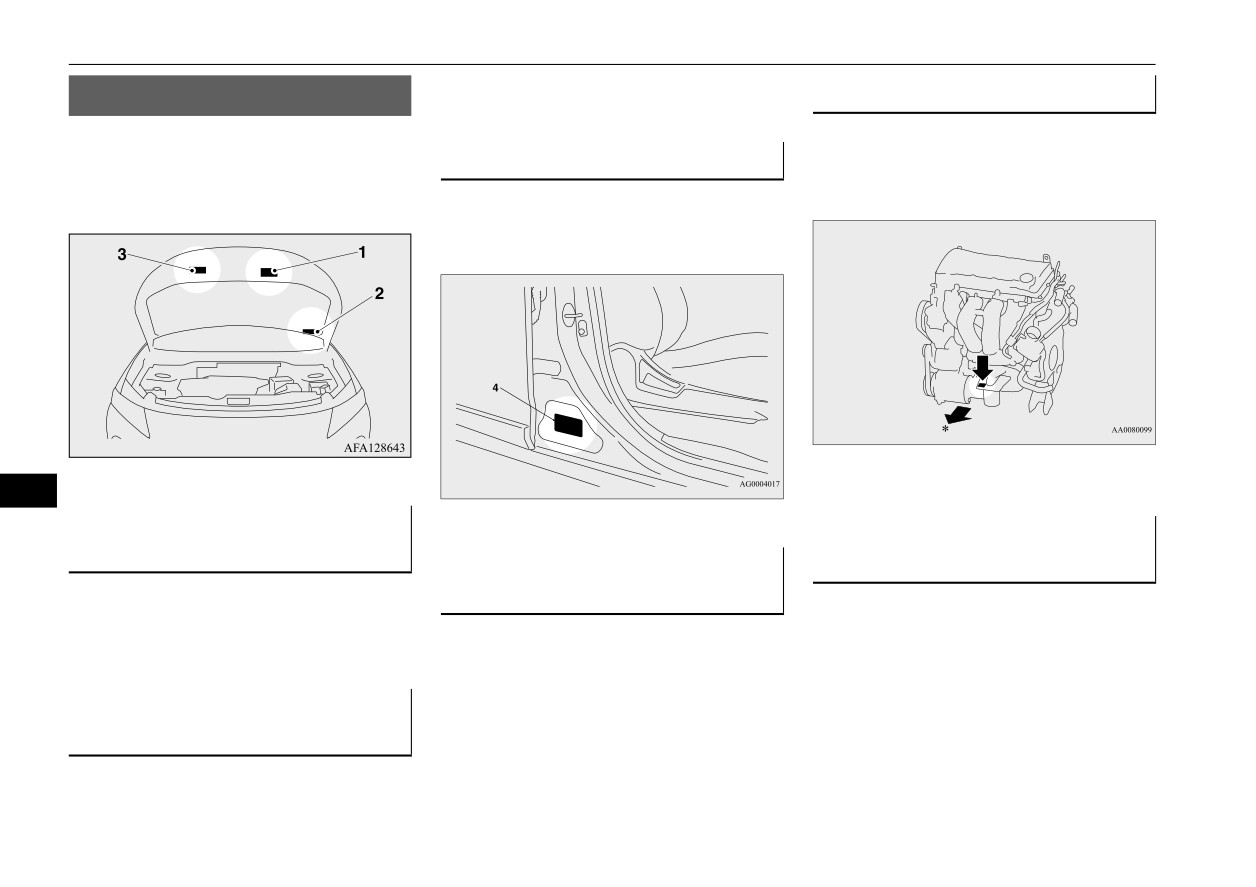
Vehicle labeling
the vehicle body. It is visible from outside of
Vehicle labeling
Engine model/serial number
the vehicle through the windshield.
N01147401941
The engine model and serial number are
Keep a record of the chassis number and
3 - Air conditioning label
stamped on the engine cylinder block as
vehicle identification number. Such informa-
shown in the illustration.
tion will assist police if your vehicle is stolen.
The air conditioning label is affixed on the
inside panel of the engine hood.
*- Front of the vehicle
11
1 - Vehicle emission control
Tire and loading information
information label
4 - Vehicle information code
placard
N01148100603
plate
The vehicle emission control information
The tire and loading information
label is affixed on the underside of the engine
The vehicle information code plate is located
placard is located on the driver’s
hood.
on the front passenger door sill.
door sill.
2 - Vehicle identification num-
ber plate
The vehicle identification number is stamped
on the plate riveted to the left front corner of
11-2
Specifications
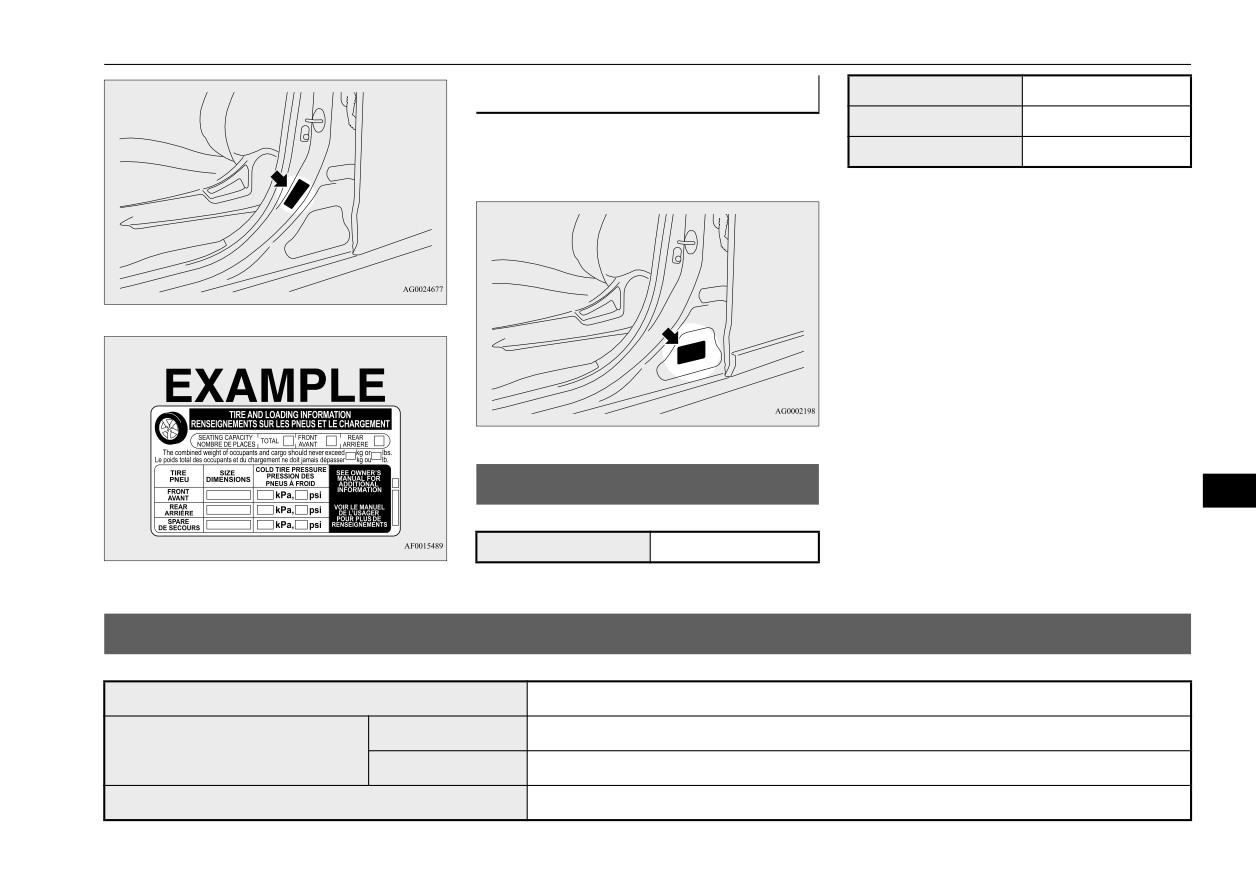
Vehicle dimensions
Overall width
71.3 in (1,810 mm)
Certification label
N01148200167
Overall height
64.8 in (1,645 mm)
The certification label is located on the
Wheel base
105.1 in (2,670 mm)
driver’s door sill.
Vehicle dimensions
11
N01147501694
Overall length
171.9 in (4,365 mm)
Vehicle weights
N01147600858
Gross vehicle weight rating
4,343 lb (1,970 kg)
Front
2,271 lb (1,030 kg)
Gross axle weight rating
Rear
2,205 lb (1,000 kg)
Vehicle capacity weight
827 lb (375 kg)
Specifications
11-3

Engine specifications
Maximum roof load
176 lb (80 kg)
Seating capacity
5 persons
NOTE
z Roof load is important because it affects the vehicle capacity weight. Refer to “Loading cargo on the roof” on
page 6-11.
GVWR: maximum total weight (load) limit specified for the vehicle
GAWR: maximum weight (load) limit specified for the front or rear axle
Seating capacity: the maximum number of occupants
Engine specifications
N01147701638
Item
2.0 liter models
2.4 liter models
11
Engine model
4B11
4B12
Engine displacement
121.9 CID (1,998 cm³)
144.0 CID (2,360 cm³)
No. of cylinders and cylinder arrangement
4 in line
Bore
3.39 in (86.0 mm)
3.46 in (88.0 mm)
Stroke
3.39 in (86.0 mm)
3.82 in (97.0 mm)
Compression ratio
10.0
10.5
Thermostat valve opening temperature
189 °F (87 °C)
Spark plugs
NGK
DIFR6C11
DIFR5C11
Spark plug gap
.040 to .043 in (1.0 to 1.1 mm)
Firing order
1-3-4-2
11-4
Specifications
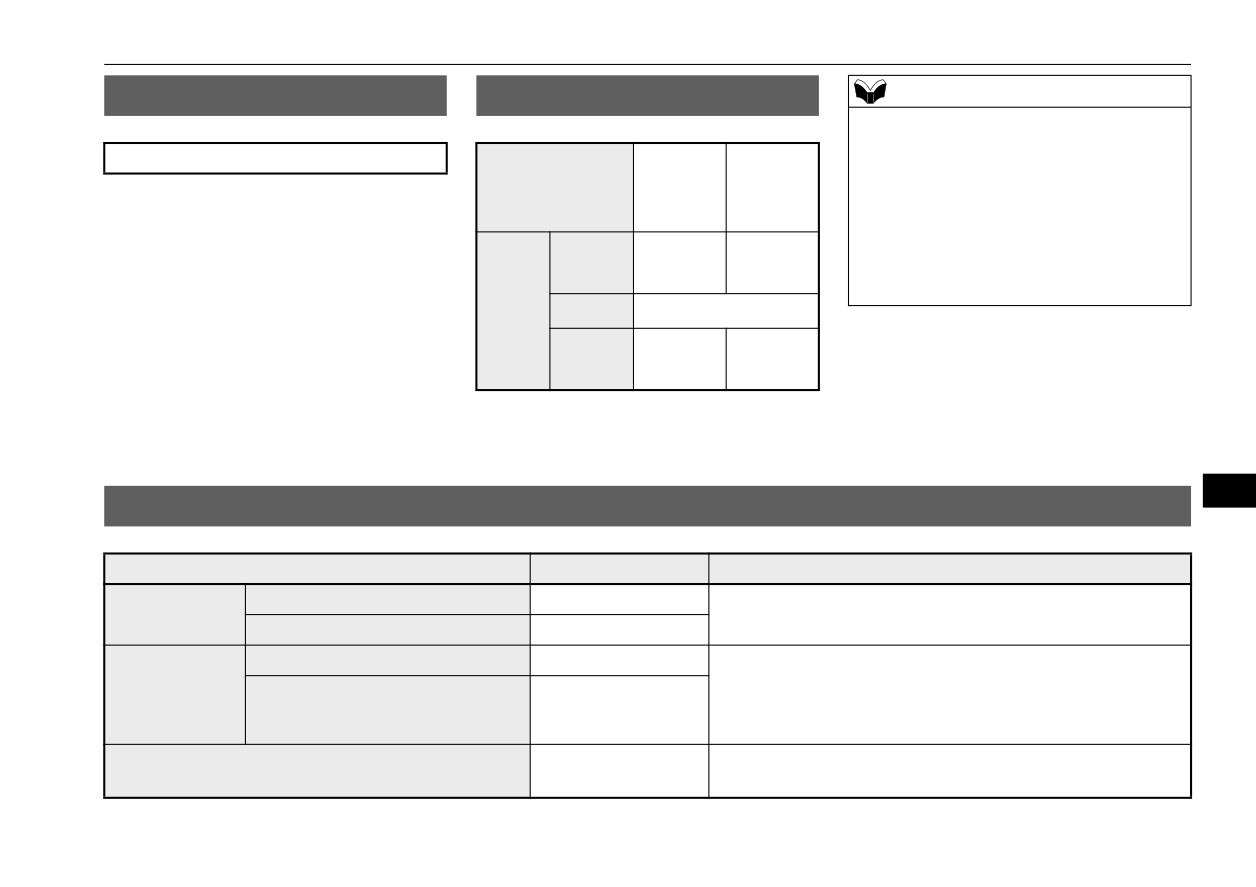
Battery
Battery
Tires and wheels
NOTE
N01147801336
N01147901904
z Contact
an
authorized
Mitsubishi Motors dealer for
75D23L
P215/
P225/
details on the combination used
Tire
70R16
55R18
Battery is a 12 volt type.
on your vehicle.
99H
97H
z These tires satisfy vehicle load-
16 x
Size
18 x 7J
ing conditions described in this
6 1/2J
owner’s manual.
Wheel
PCD
4.5 in (114.3 mm)
Offset
1.81 in
1.50 in
(Inset)
(46 mm)
(38 mm)
PCD: Pitch Circle Diameter (installa-
tion holes)
11
Capacity
N01148002459
Item
Capacity
Lubricants
Fuel
Front-wheel drive vehicles
16.6 gal (63 L)
Refer to “Fuel selection” on page 3-2.
(approximate)
All-wheel drive vehicles
15.8 gal (60 L)
Oil pan
4.5 qt (4.3 L)
Engine oils displaying the ILSAC certification mark (“star-
burst” symbol) on the container.
Engine oil
Oil filter
.32 qt (0.3 L)
If these oils are not available, API classification SP or higher
can be used.
Refer to “Continuously variable transmission (CVT) fluid” on
Continuously variable transmission (CVT)
7.3 qt (6.9 L)
page 9-9.
Specifications
11-5
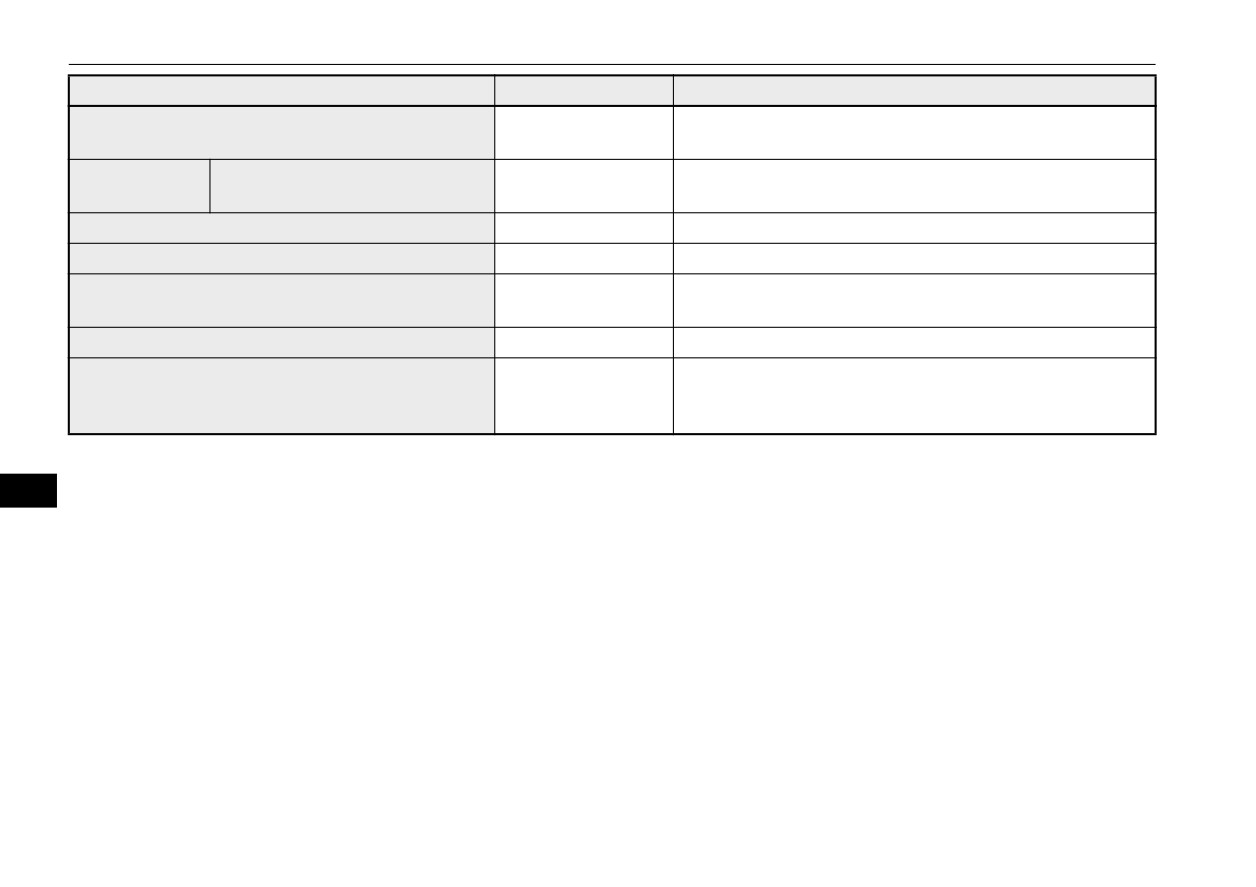
Capacity
Item
Capacity
Lubricants
Mitsubishi Motors Genuine Super Hypoid Gear Oil API GL-5
Transfer oil
.53 qt (0.5 L)
SAE 80
Mitsubishi Motors Genuine Super Hypoid Gear Oil API GL-5
Differential
Rear axle
.42 qt (0.4 L)
SAE 80
Brake
As required
Conforming to Brake fluid DOT3 or DOT4
Hood lock release mechanism and safety catch
As required
Multipurpose type grease NLGI Grade 2
Engine coolant
Mitsubishi Motors Genuine Super Long Life Coolant Premium
7.9 qt (7.5 L)
{Includes .69 qt (0.65 L) in reserve tank}
or equivalent*
Washer fluid
4.5 qt (4.3 L)
—
Refer to the “Air con-
Refrigerant (air conditioning)
ditioning label” on
HFO-1234yf
page 11-2.
*: Similar high quality ethylene glycol based non-silicate, non-amine, non-nitrate and non-borate coolant with long life hybrid organic acid tech-
nology
11
11-6
Specifications